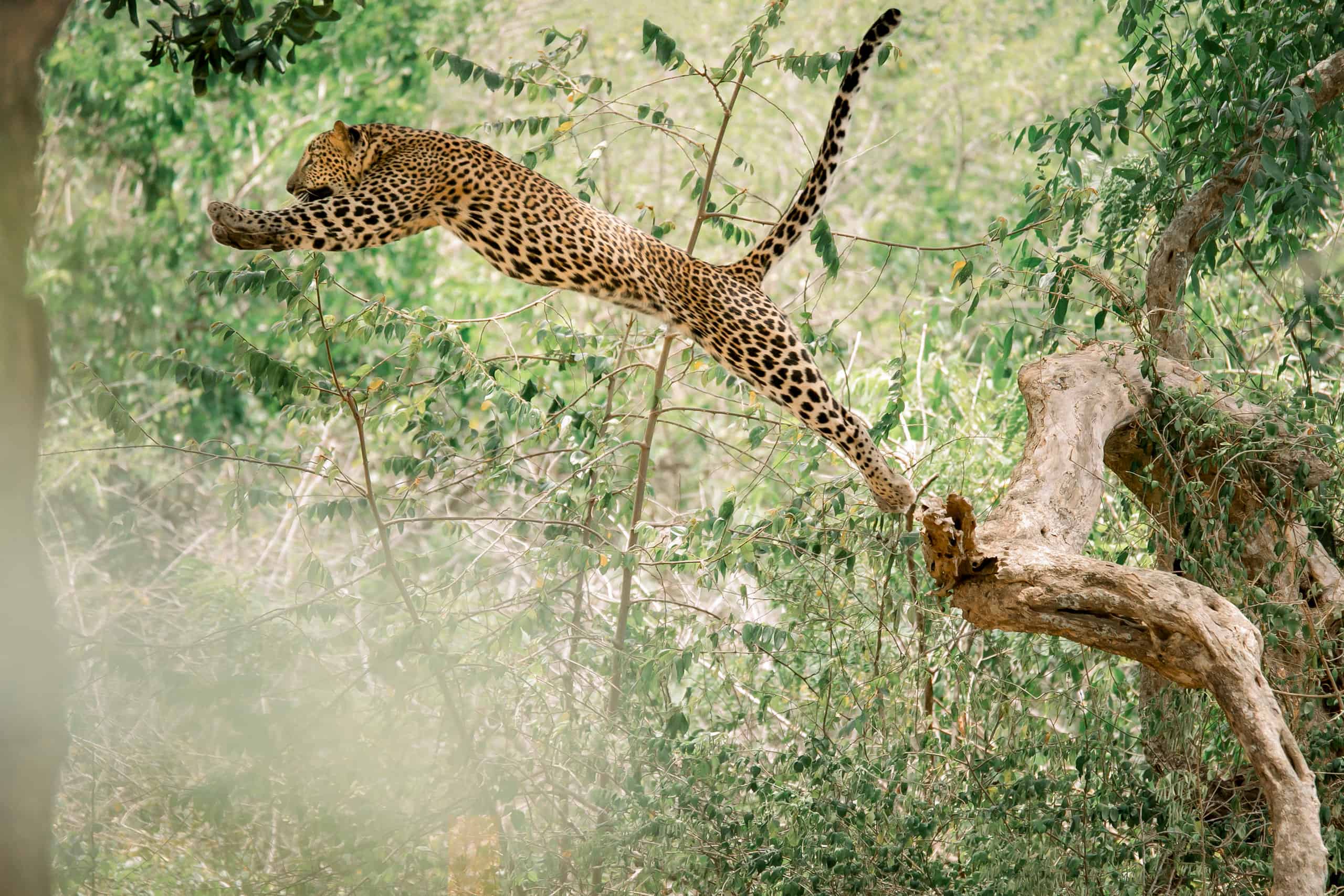Continue reading for our analysis...

Wow – what a sight to see! This video takes us right into the heat of a battle between a leopard and a hyena over a meal. Right at the start, the leopard leaps toward the hyena with claws out. The hyena retaliates, but the feline’s quick feet keep it from getting bitten. The sly cat takes the opportunity to move the hyena away from the kill. While the dog is distracted, a second leopard runs in and snatches the kill! This seems to be a win for the leopards as the hyena is left hungry. Let’s watch the action below before learning more about leaping leopards!
How High Can Leopards Leap?
Leopards are big cats. It stands to reason that, like many cats, they can jump both far and high. In fact, leopards can leap up to 20 feet across and 10 feet straight into the air!
One video caught a leopard leaping over a tall fence and attacking a car. Another shows a leopard snatching an impala right out of the air! Yet another shows a leopard making an incredible leap between two trees to catch a monkey. These amazing videos prove how astounding leopards can be.
What Makes Our Leaping Leopards Unique?
Not only can leopards make amazing jumps, but they are also strong and capable predators. Let’s learn more about leaping leopards and what makes them unique!
Adaptability

Leopards eat a wide variety of food items and can hunt in a multitude of habitats.
©Dmitri Gomon/Shutterstock.com
The leopard’s ability to adapt makes them some of the most successful big cats on the planet. Part of what makes them unique is their versatile hunting. Leopards eat anything they can catch. That includes insects, rodents, fish, monkeys, snakes, birds, and more! Because they readily catch and kill a variety of prey items, the leaping leopard rarely goes hungry.
Leopards are found throughout much of the world. Their range extends from Africa and parts of the Middle East to parts of China, India, and eastern Russia. Many populations remain endangered outside of Africa. This is due to poaching and habitat destruction. Thankfully, leopards also adapt well to different hunting environments. Their rosette-covered coat also helps them blend into many surroundings.
One study evaluated the Indochinese leopard and its hunting habits through scat (animal feces). They found that while females tend to take smaller prey, males often hunt larger animals.
Built for the Kill and Keeping It

Leopards carry their meals into trees to keep them away from other predators.
©wasantha8958/Shutterstock.com
While leopards remain one of the smallest of big cat species, their strength far exceeds their size. An adult leopard is capable of carrying about 220 pounds straight up into a tree! Because leopards often leap into trees with their kills, they increase the odds of keeping their meal. Not only that, but leopards bite down with a force of about 300 psi (pounds per square inch). That means they easily crush bone with a well-aimed bite.
All that aside, they hunt by ambush. Leopards stalk their prey and get as close as possible before leaping onto them. This technique takes the prey by surprise and is often enough for the big cat to secure a killing bite. The leopard’s heavy body and strong, short legs also help it hold prey down.
The largest prey reportedly taken down by a leopard was a male eland (a type of large antelope) weighing 2,000 pounds! Though not a usual prey item for leopards, this kill proved how mighty they are.
Water? Who Needs It?

Leopards drink water only every 2–3 days.
©Reto Beuhler/Shutterstock.com
Amazingly, leopards have one ability you might not think about. As crazy as it might seem, they don’t have to drink water every day to survive! They only visit water sources every two to three days. Leopards living in the Kalahari Desert actually eat moisture-rich plants to get the water they need! These include succulents and tsamma melons, among others.
While leopards don’t need to drink much water, they are actually amazing swimmers. Indeed, they actually enjoy the water. This also allows them to prey on fish and other water-dwelling creatures. Leopards have even been observed leaping into the water to catch escaping monkeys for dinner!
Solitary Life: A Leap of Leopards is a Rare Sight

Leopards usually live alone unless it’s a mother with cubs. A group of leopards is called a leap.
©Anup Shah/DigitalVision via Getty Images
Leopards are generally solitary creatures. They live on their own in overlapping territories and come together only for mating. Funnily enough, a group of leopards is called a leap.
A leap of leopards usually only occurs with a female and her cubs. Unlike lions and cheetahs, male leopards do not form coalitions. This seems to be beneficial to them, though. Without additional mouths to feed, leopards can hunt whatever is convenient for them and take all the nutrients from the kill for themselves.
Thank you for reading! Have some feedback for us? Contact the AZ Animals editorial team.







